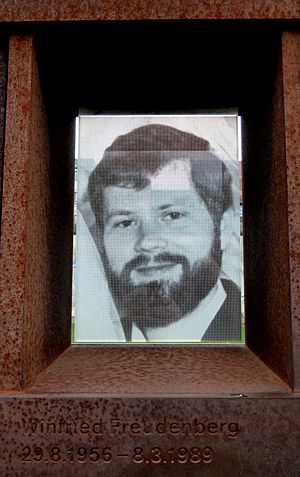Winfried Freudenberg facts for kids
Quick facts for kids
Winfried Freudenberg
|
|
|---|---|
 |
|
| Born | 29 August 1956 Osterwieck, East Germany
|
| Died | 8 March 1989 (aged 32) Zehlendorf, West Berlin, West Germany
|
| Cause of death | Home-made gas balloon crash whilst attempting to leave East Berlin 52°25′47″N 13°13′26″E / 52.4297°N 13.2239°E |
| Body discovered | Backyard of a garden villa in Zehlendorf 52°26′22″N 13°13′54″E / 52.4394°N 13.2318°E |
| Occupation | Electrical Engineer |
| Known for | Last fatality in an attempt to defect from East Germany across the Berlin Wall |
Winfried Freudenberg (born August 29, 1956 – died March 8, 1989) was the last person to die trying to escape from East Germany to West Berlin. He fell from a homemade gas balloon high above West Berlin. This happened just before the Berlin Wall came down.
Contents
Life in East Germany
Winfried Freudenberg was born in Osterwieck, a town in East Germany. He grew up in Lüttgenrode, a village close to the border with West Germany. East Germany was a communist state, meaning the government controlled almost everything. It was part of the Eastern Bloc, a group of countries allied with the Soviet Union.
Education and Career
After finishing school, Winfried trained to be an electrician. He then went to night school to get his high school diploma. Later, he studied information technology and became an electronics engineer. In 1988, he married Sabine, a chemist he met at Ilmenau University.
Why Escape?
The Berlin Wall and strict borders made it hard for people in East Germany to travel freely. Winfried and Sabine felt stuck and were disappointed by the lack of opportunities compared to the West. They wanted to live in a place with more freedom. Soon after their wedding, they began planning a daring escape. They decided to build a balloon and fill it with natural gas. Natural gas contains methane, which is lighter than air, so it can make a balloon float.
The Escape Plan
To help their plan, Freudenberg got a job at a public utility that supplied natural gas. The couple moved into an apartment in East Berlin. In early 1989, they started building their balloon. They used polyethylene plastic to make the balloon's outer shell. It was huge: 13 meters (43 feet) tall and 11 meters (36 feet) wide. Instead of a basket, they planned to stand on a narrow wooden beam.
Launch Night
On the evening of March 7, 1989, the wind seemed perfect for their escape. They drove to a gas station in Blankenburg where Winfried had keys. Around midnight, they began filling the balloon with gas.
By 1:00 AM, the balloon was so big it could be seen from far away. A waiter on his way home noticed it and called the police.
A Difficult Decision
Shortly after 2:00 AM, Winfried and Sabine heard a police car arriving. The balloon wasn't fully inflated yet. They worried it wouldn't lift both of them. Sabine had always been a bit unsure about the plan. They quickly decided that Winfried would go alone. He climbed onto the wooden beam and cut the ropes holding the balloon down.
Because only one person was on board, the balloon was very light and shot up quickly. As it rose, ropes hanging from the balloon hit a power line. This caused sparks and a short circuit. East German security often shot people trying to escape. However, they decided not to shoot this time. They feared hitting the balloon and causing a natural gas explosion. They also thought Winfried might have been killed by the electric shock. Sabine managed to get home, where the Stasi (East German secret police) were waiting for her.
The High-Altitude Journey
The homemade balloon had too much buoyancy (the ability to float). It also didn't have a proper valve to release gas. This meant it rose very quickly and much higher than planned. Winfried couldn't make it go down. He spent more than five hours floating high in the sky.
At first, the balloon drifted west-south-west. With winds around 20 km/h (12 mph), he likely reached West Berlin in about 20 minutes. Later, he passed over Berlin Tegel Airport. He may have dropped some weight there. His altitude likely increased to over 2,000 meters (6,500 feet). At this height, the wind direction changed, pushing him south.
The Fall
At dawn, the balloon was seen over Teufelsberg hill. People thought it was a weather balloon. Around 7:30 AM, just before the balloon would have flown back into East German territory, Winfried fell. He landed in the garden of a house in the Zehlendorf area of West Berlin. The remains of the balloon landed about one kilometer (1,000 yards) away.
Winfried's body was found hours later. He died instantly from his injuries. The exact reason for his fall is not clear. West Berlin police thought he might have climbed the net to cut the balloon open. He may have lost his grip during this action.
Aftermath
After the incident, East German police questioned Winfried's friends, family, and colleagues. They wanted to know if anyone else helped him plan the escape. Because of international attention, especially after another refugee was shot, Sabine received a lighter sentence. She was given three years of probation and then granted amnesty in October 1989. Just one month later, East Germany began allowing its citizens to travel to the West. Soon after, the Berlin Wall was taken down, and the two Germanys reunited.
See also
- East German balloon escape
- List of deaths at the Berlin Wall
- Berlin Crisis of 1961


